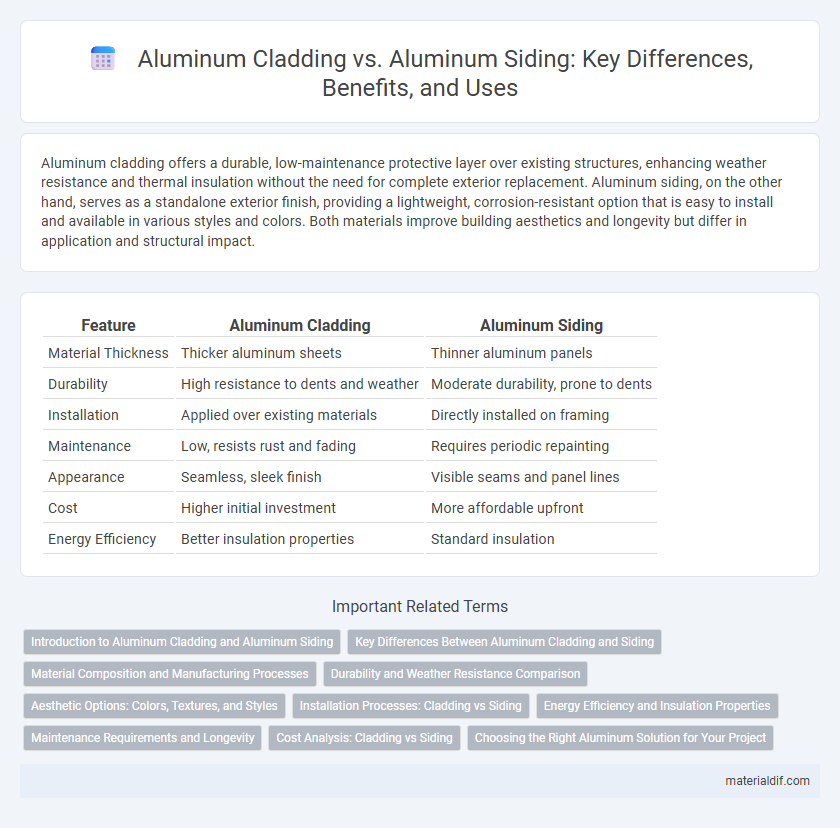Aluminum cladding offers a durable, low-maintenance protective layer over existing structures, enhancing weather resistance and thermal insulation without the need for complete exterior replacement. Aluminum siding, on the other hand, serves as a standalone exterior finish, providing a lightweight, corrosion-resistant option that is easy to install and available in various styles and colors. Both materials improve building aesthetics and longevity but differ in application and structural impact.
Table of Comparison
| Feature | Aluminum Cladding | Aluminum Siding |
|---|---|---|
| Material Thickness | Thicker aluminum sheets | Thinner aluminum panels |
| Durability | High resistance to dents and weather | Moderate durability, prone to dents |
| Installation | Applied over existing materials | Directly installed on framing |
| Maintenance | Low, resists rust and fading | Requires periodic repainting |
| Appearance | Seamless, sleek finish | Visible seams and panel lines |
| Cost | Higher initial investment | More affordable upfront |
| Energy Efficiency | Better insulation properties | Standard insulation |
Introduction to Aluminum Cladding and Aluminum Siding
Aluminum cladding provides a durable, corrosion-resistant exterior layer for buildings, enhancing thermal insulation and weather protection by covering underlying materials like wood or steel. Aluminum siding, typically thinner and easier to install, serves as a cost-effective, low-maintenance facade option primarily designed for aesthetic appeal and basic weather resistance. Both materials leverage aluminum's lightweight and anti-rust properties but differ in structural application, thickness, and performance characteristics.
Key Differences Between Aluminum Cladding and Siding
Aluminum cladding consists of thin aluminum panels applied over a wood or vinyl structure, providing durability and low maintenance, while aluminum siding is a standalone exterior material designed to protect and decorate buildings. Cladding offers enhanced insulation and a seamless appearance, often used in renovation to preserve original materials, whereas siding focuses more on weather resistance and ease of installation. The choice between aluminum cladding and siding depends on factors like budget, aesthetic preferences, and structural needs.
Material Composition and Manufacturing Processes
Aluminum cladding consists of a thin layer of aluminum bonded over wood or other substrates, combining durability with aesthetic appeal through processes like roll forming and painting. Aluminum siding, made entirely of extruded or rolled aluminum panels, undergoes treatments such as anodizing or coil coating to enhance corrosion resistance and color retention. The key distinction lies in cladding's composite structure versus siding's single-material fabrication, influencing performance characteristics and installation methods.
Durability and Weather Resistance Comparison
Aluminum cladding offers superior durability compared to aluminum siding due to its thicker protective layer, which effectively resists dents, corrosion, and fading over time. Its weather resistance is enhanced by a factory-applied finish that withstands UV rays, moisture, and harsh environmental conditions better than standard aluminum siding coatings. This makes aluminum cladding a preferred choice for long-term exterior protection in climates prone to extreme weather variations.
Aesthetic Options: Colors, Textures, and Styles
Aluminum cladding offers a sleek, modern aesthetic with a wide range of colors and smooth textures that can mimic the look of metal or wood, enhancing architectural designs with its versatility. Aluminum siding provides more traditional styles, featuring varied textures such as wood grain and horizontal or vertical panels, allowing homeowners to achieve classic or contemporary appearances. Both materials come in powder-coated finishes that resist fading and offer diverse color palettes, making them suitable for numerous design preferences and exterior styles.
Installation Processes: Cladding vs Siding
Aluminum cladding installation involves overlaying existing surfaces with aluminum panels, requiring precise measurement and cutting to ensure a seamless fit over wood or metal substrates. Aluminum siding installation, on the other hand, necessitates removing old siding before securely nailing or fastening new aluminum panels directly to the exterior framing. Cladding offers a more straightforward retrofit process with minimal demolition, while siding installation demands careful preparation of the underlying structure to ensure durability and weather resistance.
Energy Efficiency and Insulation Properties
Aluminum cladding offers superior energy efficiency compared to aluminum siding due to its enhanced insulation properties and ability to reduce thermal bridging. The cladding incorporates a thermal break and insulating layers that improve heat retention and lower energy consumption in buildings. In contrast, aluminum siding primarily serves as a protective exterior layer without significant insulating capabilities, making it less effective in enhancing overall energy performance.
Maintenance Requirements and Longevity
Aluminum cladding offers superior durability with a maintenance requirement limited to occasional cleaning and minor touch-ups, ensuring long-lasting protection against weather and corrosion. In comparison, aluminum siding requires more frequent upkeep such as repainting and dent repairs to maintain both appearance and structural integrity. Longevity for aluminum cladding often exceeds 50 years, while aluminum siding typically lasts around 30-40 years depending on environmental exposure and maintenance quality.
Cost Analysis: Cladding vs Siding
Aluminum cladding typically incurs higher upfront costs compared to aluminum siding due to its enhanced durability and low maintenance requirements, which reduce long-term expenses. Aluminum siding offers a more budget-friendly initial investment but may demand frequent repairs and repainting, increasing total ownership costs over time. Evaluating lifecycle costs reveals that cladding often provides better value despite the steeper initial price, making it a cost-effective choice for long-term projects.
Choosing the Right Aluminum Solution for Your Project
Aluminum cladding offers superior durability and weather resistance, making it ideal for protecting structural elements, while aluminum siding provides an affordable and low-maintenance option primarily designed for exterior walls. When choosing between aluminum cladding and siding, consider factors such as the specific application area, desired aesthetic, insulation properties, and long-term performance requirements. Selecting the right aluminum solution ensures optimal protection and enhances the overall energy efficiency and appearance of your project.
Aluminum Cladding vs Aluminum Siding Infographic

 materialdif.com
materialdif.com